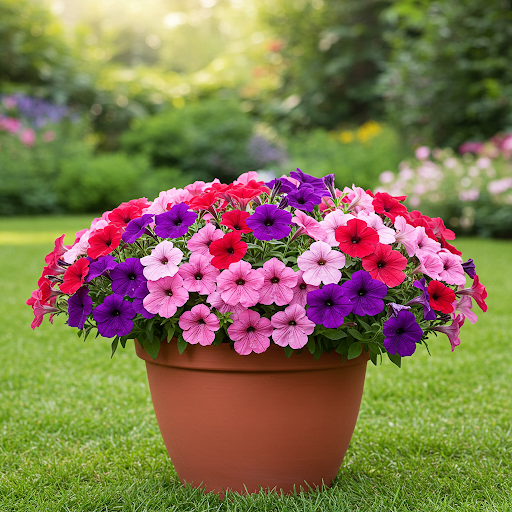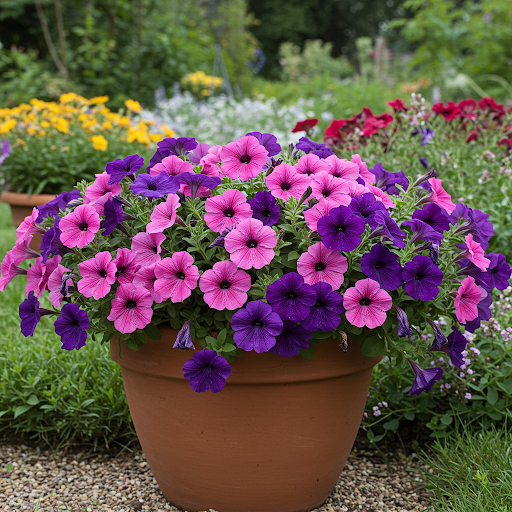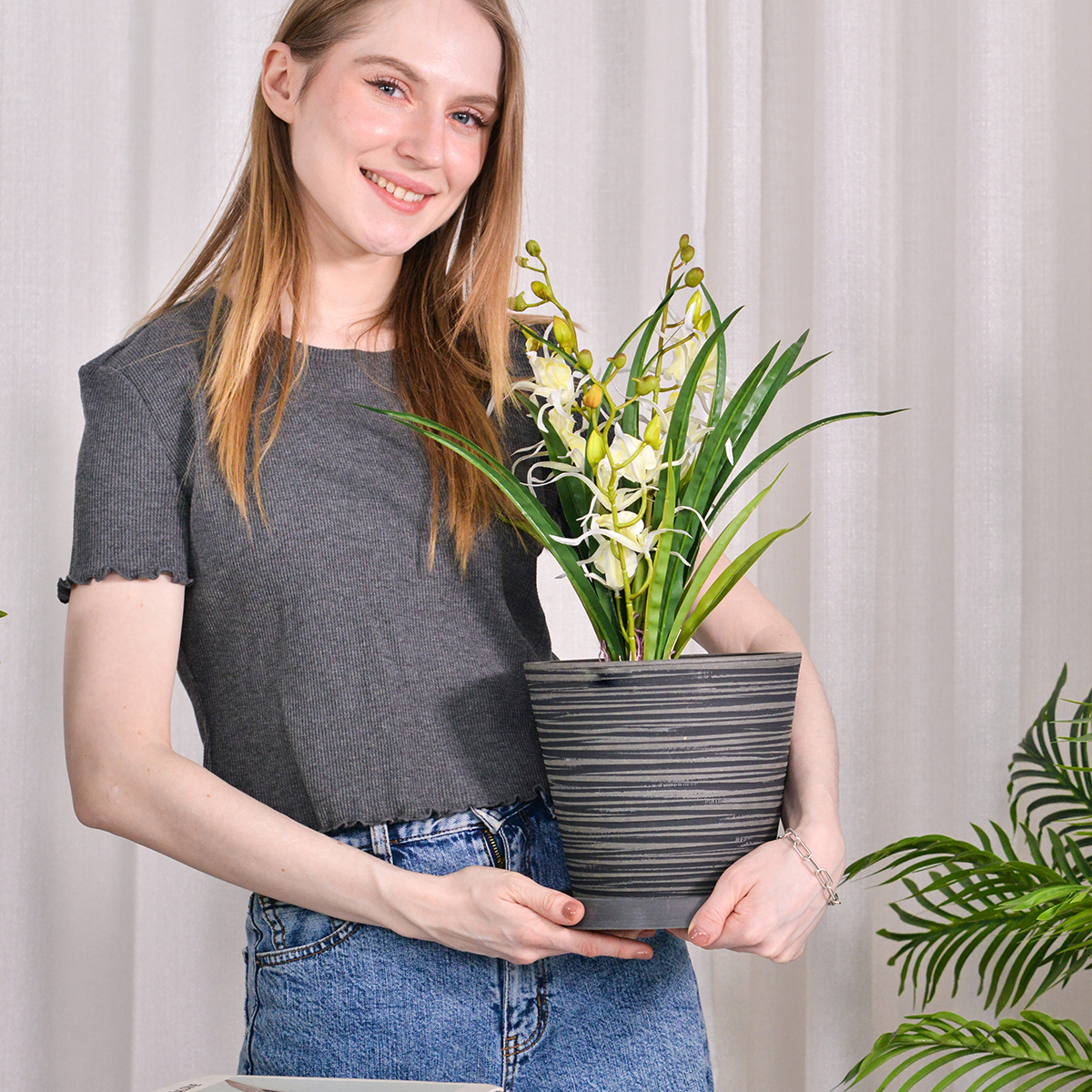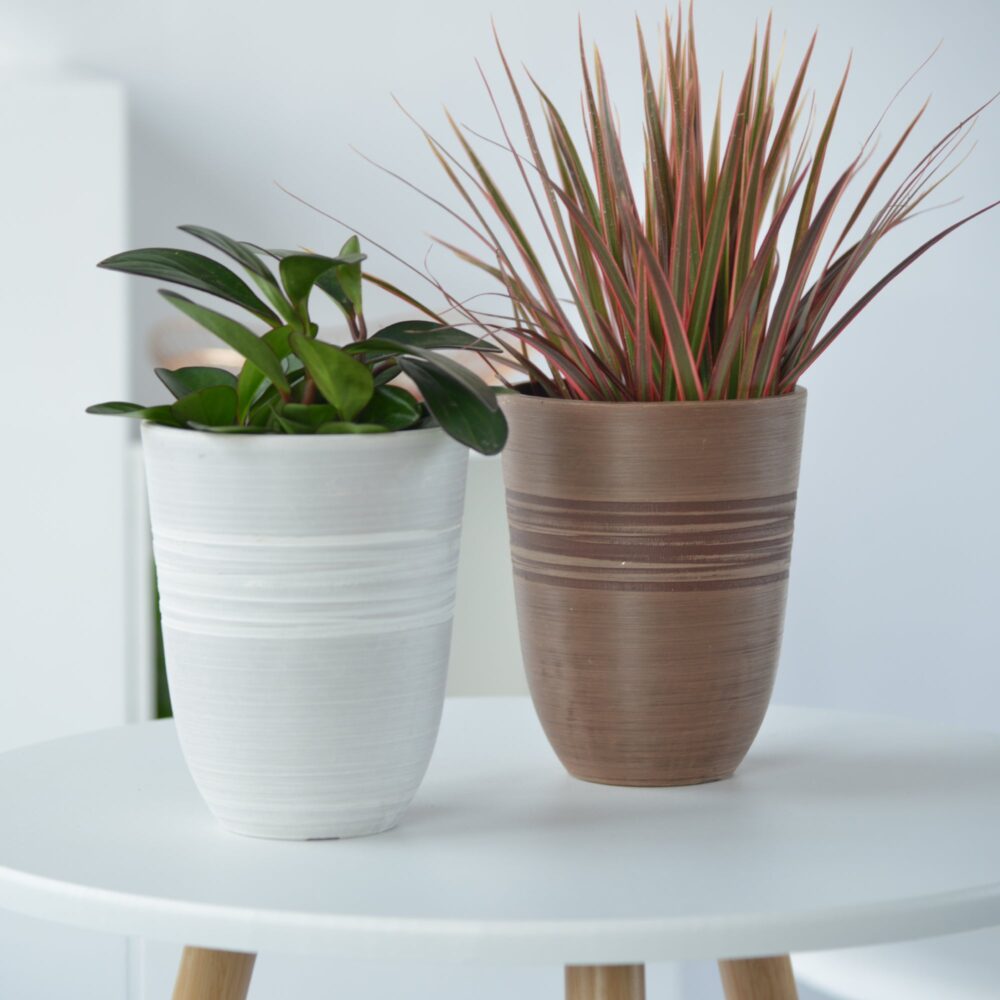Petunias: The Versatile Blooms for Sunny Gardens
Petunias, belonging to the Solanaceae family, are among the most popular annual flowers, celebrated for their prolific and vibrant blooms that come in a vast spectrum of colors, patterns, and forms. From single and double blooms to ruffled and veined petals, petunias offer endless possibilities to brighten up gardens, balconies, and patios. Native to South America, these cheerful flowers are relatively easy to grow, making them a favorite for both novice and experienced gardeners.

Ideal Growing Conditions:
- Sunlight: Petunias are sun-worshippers and thrive in full sun, requiring at least 6-8 hours of direct sunlight each day to produce abundant blooms. While they can tolerate partial shade, they will flower less and may become leggy.
- Soil: They prefer well-draining soil that is fertile and slightly acidic, with an ideal pH between 6.0 and 7.0. For containers, use a high-quality potting mix. In garden beds, amend heavy clay or sandy soils with compost or other organic matter to improve drainage and fertility.
- Watering: Petunias need regular watering, especially when newly planted and during hot, dry periods. Water deeply when the top inch of soil feels dry to the touch. Avoid overhead watering to prevent fungal diseases; water at the base of the plants instead. While they need consistent moisture, they also dislike being waterlogged, so ensure good drainage.
- Temperature: Petunias are warm-weather annuals and thrive in temperatures between 60°F to 90°F (15°C to 32°C). They are sensitive to frost and should be planted outdoors after the last spring frost.
Planting Petunias:
- Starting from Seeds or Plants: Petunias can be started from seeds indoors 10-12 weeks before the last frost, but they are more commonly purchased as bedding plants from nurseries for ease of planting.
- Spacing: When planting petunias in garden beds or containers, space them 8-12 inches apart, depending on the variety, to allow for adequate air circulation and growth. Spreading types may need more space.
- Planting Time: The best time to plant petunias outdoors is in the spring after the last frost, once the soil has warmed up.
Choosing Pots:
- Suitable Pot Types: Petunias are versatile and can be grown in almost any type of container, including plastic, terracotta, ceramic, and hanging baskets. Terracotta pots are beneficial for drainage and aeration, while plastic pots retain moisture well. Hanging baskets and window boxes are particularly popular for showcasing trailing petunia varieties.
- Drainage: Excellent drainage is crucial for petunias to prevent root rot. Ensure all pots have drainage holes.
- Pot Size: Choose pot sizes that are appropriate for the petunia variety. For individual plants, pots that are 6-12 inches in diameter are generally suitable. For combination planters or larger displays, choose larger containers.
- Potting Mix: Use a well-draining, lightweight potting mix. You can also add slow-release fertilizer to the potting mix at planting time to provide nutrients throughout the growing season.

Care Tips:
- Fertilizing: Petunias are heavy feeders and benefit from regular fertilization to support their prolific blooming. Use a balanced, water-soluble fertilizer every 1-2 weeks, or use a slow-release fertilizer incorporated into the soil at planting. For best results, use a fertilizer formulated for flowering plants.
- Deadheading: Regular deadheading, or removing spent flowers, is essential to encourage continuous blooming and keep petunias looking their best. Pinch off faded blooms along with the sticky seed pod just behind the flower.
- Pinching Back: For bushier growth, especially in leggy varieties, pinch back the tips of the stems when plants are young. This encourages branching and more flowers.
- Watering Technique: Water at the base of the plants to keep foliage dry and minimize the risk of fungal diseases. Water in the morning to allow foliage to dry before evening.
Varieties of Petunias:
- Grandiflora Petunias: Feature very large flowers, up to 5 inches across, but can be more susceptible to weather damage.
- Multiflora Petunias: Produce smaller, but more numerous flowers, and are generally more weather-resistant.
- Milliflora Petunias: The smallest petunia flowers, but extremely abundant and weather-tolerant.
- Wave Petunias (Spreading Petunias): Known for their spreading habit, perfect for ground cover, spilling over containers, and filling large areas with color.
- Cascadia and Surfinia Petunias (Trailing Petunias): Ideal for hanging baskets and window boxes, with a beautiful trailing growth habit and abundant blooms.
- Double Petunias: Feature extra petals, giving them a ruffled, carnation-like appearance.
In summary, Petunias are a wonderful choice for adding a burst of color to any sunny garden setting. Their wide variety of colors, forms, and growth habits ensures there’s a petunia for every garden style and preference. By providing them with plenty of sunshine, well-drained soil, regular watering, and fertilization, you can enjoy their spectacular blooms from spring until frost.
For more detailed information, you can visit the Wikipedia page on Petunia.
11TH
By greenship|2024-08-13T02:50:25+00:00August 13, 2024|Categories: Hand-carving Series|
20T
By greenship|2024-08-13T06:42:22+00:00August 13, 2024|Categories: Hand-carving Series|
KC3-14A
By greenship|2024-08-16T06:26:30+00:00August 16, 2024|Categories: Hand-carving Series|
K2-11T
By greenship|2024-08-13T04:21:25+00:00August 13, 2024|Categories: Hand-carving Series|
Modern Plant Pots丨Planter for Indoor Plants,8 inch or 10 inch Plant Pots with Drainage Hole,Decorative Flower Pots
By greenship-seo|2025-04-10T08:32:55+00:00January 7, 2025|Categories: Hand-carving Series|Tags: Decorative Flower Pots, Self-Watering Pots|
Plant Pots 6 inch 8 inch 10 inch for Indoor Plants, Set of 3 Modern Decorative Planter ts with Drainage Hole, Decorative Flower Pots
By greenship-seo|2025-04-10T06:39:28+00:00January 14, 2025|Categories: Hand-carving Series|Tags: Decorative Flower Pots|






